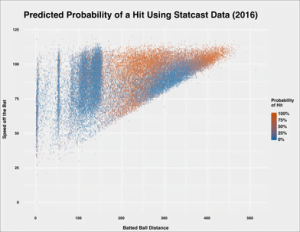Ball striking is something that has gained more traction of late in the game of golf. With advancements in motion capture technology, flight simulators and ball tracking radars it is now possible to see how well someone is able to deliver the club to the ball consistently. Having the ability to deliver the club to the ball efficiently and consistently is called ball striking. This is something that I would like to take a little time and try and apply to baseball. Now, some of the differences between baseball and golf are: the ball is not moving in golf, excessive velocity in baseball, different planes of break from different pitches, time constraint in baseball, and not needing to hit a specific target in baseball per say such as a green in golf. Because of this, we are not able to directly transfer the term ball striking from golf to baseball. But we can apply some of the same concepts. Two major factors that go into “ball striking” for baseball are: attack angle and launch angle. These two metrics are very closely related when it comes to the overall result which includes launch angle, direction and exit velocity.
Ultimately, we as hitters want to transfer as much energy from the body, to the bat, and through the ball as efficiently as possible. We also want to create the biggest collision between the bat and the ball. When this happens exit velocity greatly increases and as a result we are more likely to get a positive result i.e. reaching base. Statistics have definitively shown that the harder someone hits the ball the more likely they are going to get on base. Besides specific movement patterns while swinging, the “crispness” of our contact with the ball is extremely important in determining the overall end result. This is where collision dynamics comes in. (Courtesy Of FanGraphs.com)**


**Note closeness of the launch and attack angle of the hit**
In the end, we are really looking to get the player to develop the ability to drive the ball with excessive velocities that they are individually capable of. If one player has a high exit velocity of 105 mph and he miss hits a ball and it comes off the bat at 94 mph that is still a velocity that can generate plenty of distance and positive results. Versus another player that has a high exit velocity of 95 mph and he misses a ball and it comes off the bat at 84 mph and a launch angle of 35* this is most likely not going to produce as great of results over the long term.
So where do we go from here? Some of the most important work and help that we can provide our athletes is to give them more feedback and specific result oriented numbers. If someone does not know what their average attack angle is then they cannot piece together their best plan of attack when it comes to them trying to set external oriented goals for themselves. One of the best drills that I like to use when making a hitter more aware of their angles is a drill I like to call “ball striking”. When executing this drill we like to use the BLAST baseball sensor and HitTrax. These two are very reliable in showing our attack and launch angle, with this we can make them more aware. First, we like to start on the tee and set a goal for them beforehand such as a 25° launch angle with an attack angle of 15°. This type of immediate feedback shows them how off they are in transferring as much energy through the ball as possible. 99% of the time they feel as if they are swinging straight up and when they get their feedback they quickly find that they are not doing that at all, it is more of a feel. Then we would graduate to front toss and then overhand.
With this knowledge, we have seen great results in hard hit contact percentage and exit velocity average increase. I also believe this adds an element of difficulty for the players to try and closely match their two angles, which increases attentiveness and engagement. Let me know your thoughts.
-RC
